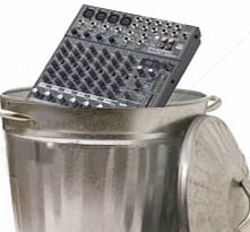
5. Mix in your keyboards. Keys can be used for everything from a grand piano sound to 80′s synth pads.
Keyboards that are used for a large pad sound can get lost in a bit of the bass and the toms.
Start with enabling the HPF, high pass filter, and then listening for the frequency space the keyboard is filling.
Make your adjustments accordingly so the pads have their own sound and aren’t lost with the other instruments.
6. Mix in the guitars. Start with the electric and the move to the acoustic. All the time, think about how the existing sounds in the mix are blending with what you have on the stage. You might not have a bass player. In that case, give that electric guitar some space in the lower frequencies.
A key point to remember is you should make a small band sound big and a big band sound small. That is to say, in the case of a big band, tighten up the frequency range of each instrument so you can easily pick it out in the mix.
A popular topic in guitar mixing is whether or not to use the HPF. Mixing is an art and therefore, there is no black and white answer as to when to use the HPF on a guitar. Use your ears. You know what you want to hear, listen for it and use what you have to reach that sound.
—EQ an Acoustic Guitar
—Mixing Multiple Guitars
—Common Acoustic Guitar Mixing Mistakes
7. Mix the vocals. Start by using the high pass filter to cut the very low end frequencies. This will help eliminate any extra low end coming from instruments like the drums.
Next, try boosting in the 6 kHz range to give some brightness and clarity to the vocals. Finally, consider cutting the problem frequencies that can exist in the 2.5 kHz to 4 kHz range.
—General Vocal EQ Settings and Theory
—More on EQ’ing Vocals
You might have other instruments that I haven’t listed. If so, mix them in where they seem appropriate. For example, mix in the violin after the acoustic guitar.
8. Mix across channels. You know it’s not as easy as mixing instruments individually and then you are done. During the process of mixing all sound together into the right sound you want, keep in might the arrangement of the song.
For example, if the song calls for the keyboard to be the focal point, then make it the focal point by giving it room in the mix. You can do that not only by using volume but by making slight frequency cuts in instruments that share the same frequencies as the keyboard. You don’t have to cut them out completely… just think of it as making room for the keyboard to be obvious as the lead instrument.
9. Add your effects. This can be done after you mix across all channels or during that mixing. A simple rule of thumb is do everything you can with your EQ work and then use the effects to fill in what is missing.
Otherwise, you’ll find yourself battling against the EQ and the effects because you are trying to get the effects to do something that’s better done with the EQ.
Summary
Van Gogh painted over his own artwork because he didn’t like what he’d painted the first time. C.S. Lewis likely had a few drafts of Narnia chapters that got tossed in the fireplace.
There will be times when you don’t nail the mix and your next move shouldn’t be reworking that mix. Your next move should be starting over.
Ready to learn and laugh? Chris Huff writes about the world of church audio at Behind The Mixer. He covers everything from audio fundamentals to dealing with musicians, and can even tell you the signs the sound guy is having a mental breakdown.
